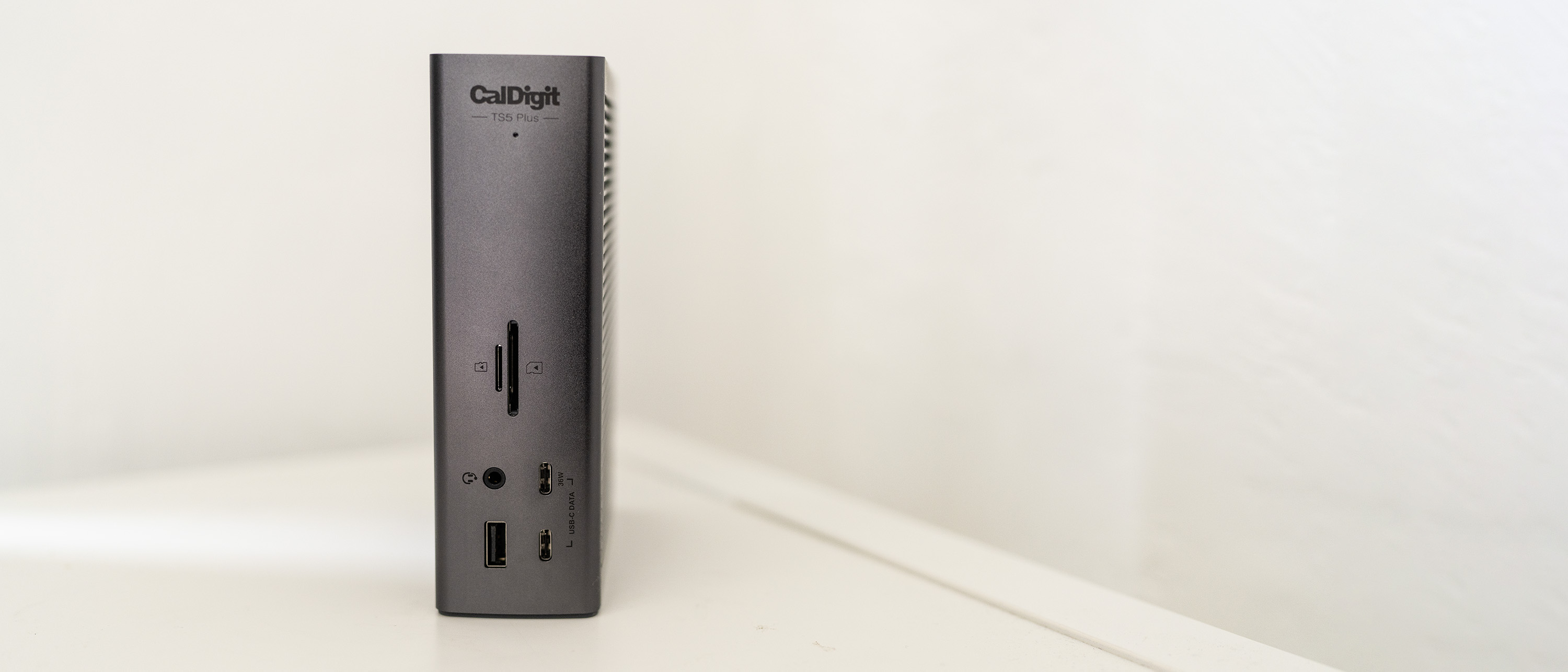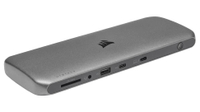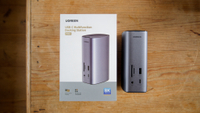Our Verdict
Caldigit's latest Thunderbolt dock, the TS5 Plus, has a lot of ports and provides a tidy single-cable connection to your laptop. It's pricy, but if you can make use of it, it could be indespensible.
For
- Very fast
- Lots of ports. LOTS.
- Keeps your desk tidy
Against
- Expensive
- Large power brick
- Many ports will go unused
Why you can trust Creative Bloq
Twenty. 20. Is that a lot? When it comes to the number of ideas you can have in a day of manic productivity, maybe not. But when we’re talking about the number of ports replicated on the back (and front) of a Thunderbolt 5 dock, which can be connected to your MacBook Pro or other TB5-equipped laptop with a single cable, then it’s a great many indeed.
The 20 ports on the Caldigit TS5 Plus can all be used at the same time, though I’m not entirely convinced you’ll actually want to do that. The ports you will use, however, are extremely fast, and having so many on what will definitely threaten the best docks on the market is very convenient - you may never have to fumble around for an adapter again.
Key specifications
Host port | Thunderbolt 5 (120Gb/s) |
Downstream ports | 2 x Thunderbolt 5 (80Gb/s), 5 x USB-C (10Gb/s), 5 x USB-A (10Gb/s), 1 x DisplayPort 2.1, 1 x SD 4.0 (UHS-II), 1 x microSD 4.0 (UHS-II), 1 x Ethernet (10GB), 2x 3.5mm audio out, 1x 3.5mm audio in |
OS | Windows 11, macOS 15 or newer |
Requires | Thunderbolt 3/USB 4 or better |
Dimensions | 155 x 47 x 128mm |
Weight: | 900g |

Design and build
• Chunky metal box
• All ports easy to access
The Caldigit TS5 Plus looks rather like a mini PC itself, with a power cord, DisplayPort, and lots of USB. It takes a chunky approach to making a framework to hang all those ports on, wider and lower than the Anker Prime TB5 dock, but able to be placed both horizontally or vertically and between other desktop items as there are only ports on the front and back.It looks almost identical to Caldigit’s previous dock, the TS4, and if you’re in the habit of keeping books on your desk, it could fit between them like a short hardback.
The dock is made of metal and sports a fashionable ridged finish. It’s available in what Caldigit calls Space Black, but which is really a dark, metallic grey. The ports are all labelled and sensibly laid out, with the power and Ethernet sockets at the bottom at the back, to make the other ports more accessible. The only exception to this is the DisplayPort, which is full-size and on top of the USB-C ports if the dock is in a vertical orientation, meaning its cable may cover them.
Overall, it’s a layout that makes it easy to plug and unplug peripherals, while flash drives are more likely to be plugged into the front-mounted ports. Putting the SD card readers on the front rather than the side is a big plus for accessibility over the Anker Prime dock too.
Design score: 4/5
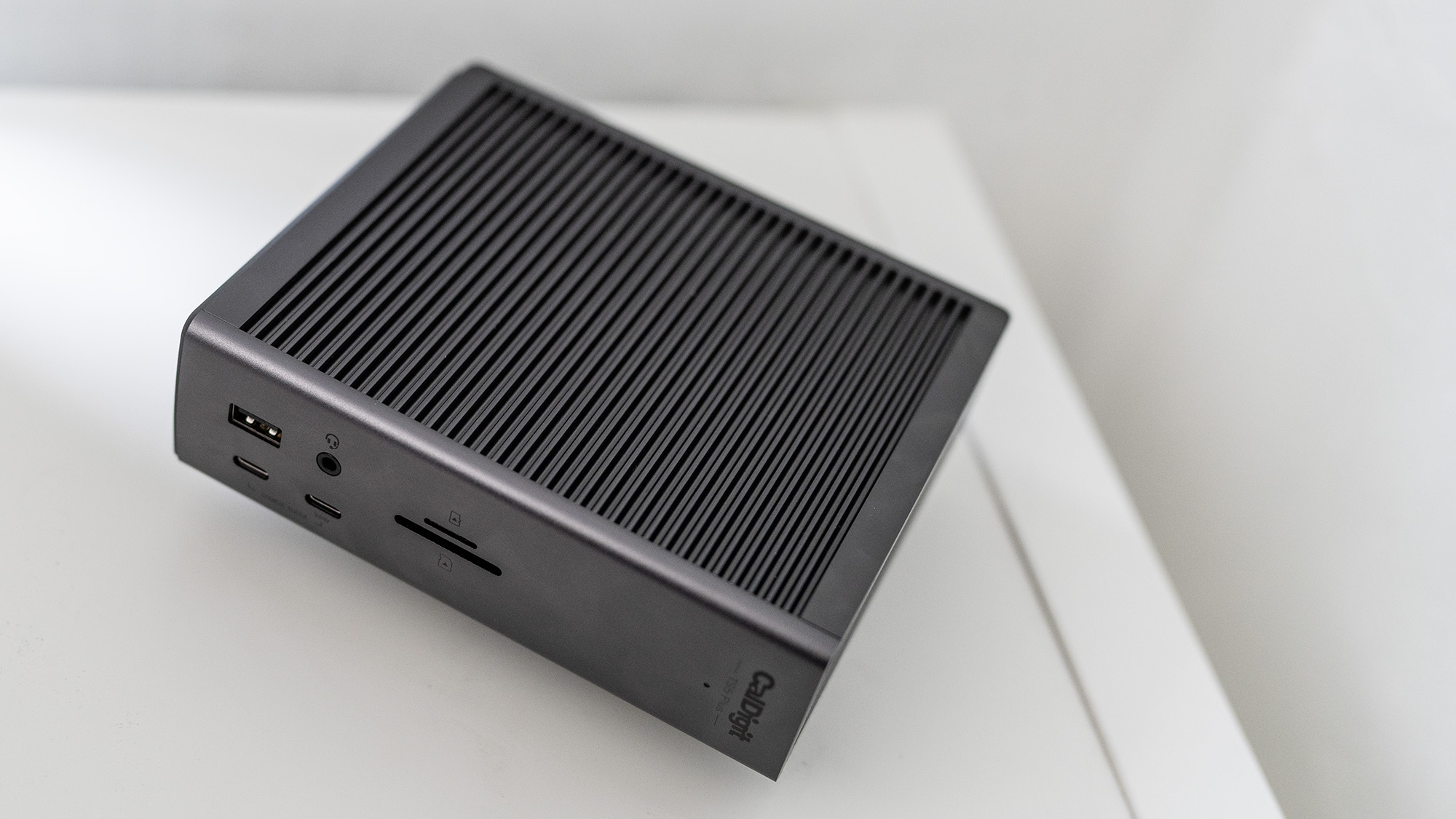
Features
• Lots of fast connectivity
• Good charging power
The dock connects to your Mac - or a Windows PC with Thunderbolt 5, though these are rarer right now - with a single cable, which both charges and transfers data. You can use it with slower connections - Thunderbolt 4 and 3, as well as USB4, but you won’t get the best performance.
The Caldigit TS5 Plus is mains-powered, and is able to divert this juice out through its USB ports. The host Thunderbolt port is capable of powering a laptop at up to 140W - the same power as both Apple’s best USB-C charging block and Anker’s TB5 dock. You can charge your phone from it too, with 36W available from a front USB-C port. Being able to connect with just one cable this way is a great way to keep your desk tidy, and Caldigit bundles a 1m braided Thunderbolt 5 cable in the box for just this purpose. If you want to connect it to the maximum supported 10Gb Ethernet you’ll need a network that runs at those speeds, but it’s nice to see.
The power brick is a little chunky, but it’s going to be hidden under your desk most of the time anyway, and the 330W it’s capable of providing means all the ports get power all the time, without needing to worry about rationing it out. You also get two rubber strips which can be threaded onto the dock’s ridges to provide extra grip on a hard surface, which is a nice addition.
Feature score: 5/5
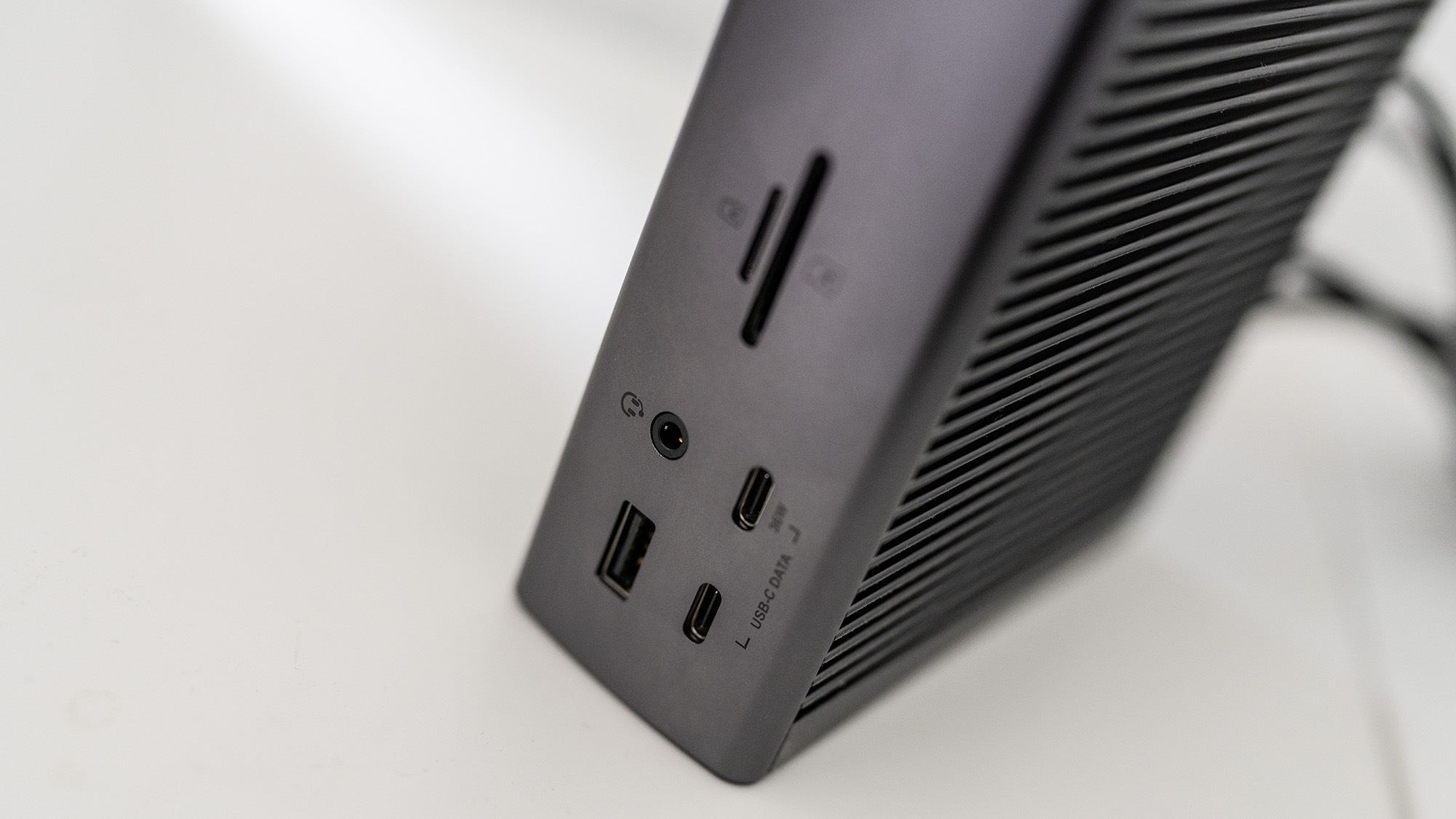
Performance
• All ports available at once
• Slight data transfer overhead
Having this many ports at your disposal is a great feeling if you’ve ever looked at the four USB-C ports on the side of a MacBook Pro and wondered how you’re going to fit a mess of adapters and chargers on them. It leaves three of them free for attaching fast SSDs like the LaCie Rugged Pro 5, but really everything you need is on the dock and it all runs fast enough when connected by Thunderbolt 5 that you can largely ignore any ports on your actual laptop.
Does the Caldigit dock slow down a Thunderbolt 5 SSD? I hooked it up to a Mac and used the LaCie Rugged SSD to find out. When attached directly, this drive is capable of read speeds of 6956.33 MB/s and write speeds of 5272.78 MB/s. When connected via the Caldigit TS5 Plus, tested speeds were 6758.4 MB/s read and 4578.4 MB/s write - so while there is clearly an overhead from using the dock, it’s not that great and the TB5 drive is still running faster than a USB4 drive like the Sandisk Extreme Pro (and that drive is already fast enough for most creative endeavours).
Having a DisplayPort output on the dock rather than an HDMI is perhaps a curious choice, as it’s a less familiar cable type, but you also have Thunderbolt ports that can be adapted to HDMI, and DP to HDMI cables are cheap and common - as are DP connections on monitors, so there's no reason not to use it. On macOS, the dock supports up to dual 8K displays, though you’ll need a Mac that can handle this, and on Windows Thunderbolt 5 PCs, it supports up to three 4K 144Hz displays.
Another neat feature of the dock is its backwards compatibility - you can hook it up to computers sporting Thunderbolt 3 or 4 (or USB4) and it will work. You won’t get full speed or functionality from it, though, and you’ll be able to buy a dock better suited to those computers for a lot less cash.
Performance score: 5/5
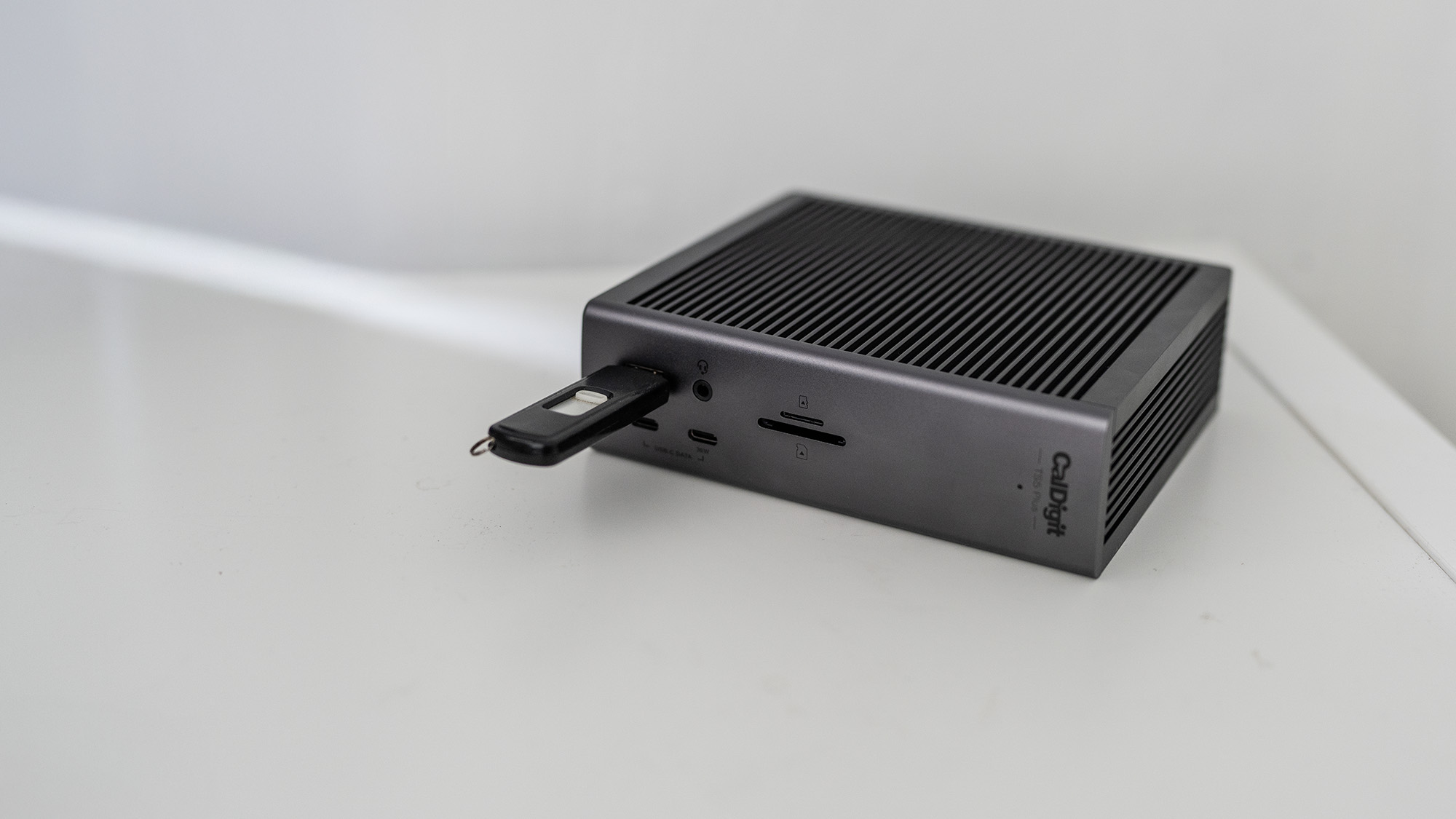
Price
If you want the speed and convenience of the Caldigit dock you’re going to have to pay for it, but that’s true of all Thunderbolt 5 kit at the moment, even the cables. At £469.99 / $499.99 it’s more expensive than the Anker Prime TB5 dock, and a lot pricier than most Thunderbolt 4 or basic USB-C docks. If it has to be Thunderbolt 5, you need all those ports, and want the ability to use them all at the same time, then it might be worth the cost.
Value score: 3/5
Who is it for?
• Home workers
This is for the sort of person who uses a laptop with Thunderbolt 5 at a desk, with lots of external monitors and flash drives and other peripherals, but who wants to disconnect it at a moment’s notice to head out and do something more exciting with it. Then come back and back up all that exciting stuff to a fast external drive, all while keeping a clear desk.
Attributes | Notes | Rating |
|---|---|---|
Design: | A bit flat and grey, but highly accessible | 4/5 |
Features: | All the ports you could ever need | 5/5 |
Performance: | Slight transfer overhead, but not much | 5/5 |
Value: | Expensive and a bit niche | 3/5 |

Buy it if...
- Thunderbolt 5 excites you
- You’ll use most of the ports
- You want a tidy desk
Don't buy it if...
- Something cheaper will do
- Something slower will do
- You like wires
Also consider
The Anker Prime TB5 Docking Station will be worth the outlay if you can make use of its blazing speeds and multiple connections.
The Rolls Royce of Thunderbolt 4 docking stations. You get 10 ports in total, plus passthrough charging, support for Thunderbolt 4, and the ability to connect two 4K monitors at once, at 60fps.
A good, if not perfect, dock that provides high-quality file transfer and three versatile display ports to enhance workflow and offer a variety of solutions to creative users.
out of 10
Caldigit's latest Thunderbolt dock, the TS5 Plus, has a lot of ports and provides a tidy single-cable connection to your laptop. It's pricy, but if you can make use of it, it could be indespensible.

Ian Evenden has been a journalist for over 20 years, starting in the days of QuarkXpress 4 and Photoshop 5. He now mainly works in Creative Cloud and Google Docs, but can always find a use for a powerful laptop or two. When not sweating over page layout or photo editing, you can find him peering at the stars or growing vegetables.
You must confirm your public display name before commenting
Please logout and then login again, you will then be prompted to enter your display name.
